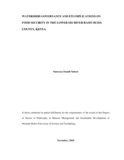| dc.description.abstract | Efforts to implement Integrated Water Resource Management are often hamperedby inefficient political and institutional environments. As a result, Lower Sio River basinhas experienced land use and land cover changes which have exerted negative ecological impacts on locallivelihoods. It is unclear how much watershed governance isintegrated into policy across the county levelsto promote food security. Therefore, the study aimed at determining the status of watershed governance and its place in enhancing food security in the Lower Sio River basin; Nambale, Matayos and Funyula Sub-counties in Busia County, Kenya. The specific objectives were to: determine the perceptions of households on changes in rural watershed governance; examine the adaptive capacity of state and non-state institutions to enhance watershed governance for food security; evaluate the impacts of watershed governance structures on rural food security; and evaluate the effectiveness of adaptive co-management of watershed governance for food security. Cross-sectional and evaluation research design; qualitative and quantitative approaches, and probability and non-probability sampling techniques were used to ensure triangulation and cross-checking the research process. A structured questionnaire, interview guide, focus group discussion guide and observation checklist were tools used to collect data. Two-level multi-stage sampling was combined with simple random and proportionate sampling to select a sample of 387 households for quantitative data. Purposive, convenient and snowball sampling procedures were used to select asample for key informants’interviews and focus group discussions. Descriptive statistics, bi-variate, Chi-square and T-test, context and qualitative analysis were done. The study found that 75.2% of the households’ depended on farmlands for food while 81.9% agreed that watershed governance determined food security. Consequently, 86.3% needed changes in watershed governance systems. Creating social resilience to adapt to a changing climate, and clarifying roles and responsibilities at p-value=0.000; enhancing water-use efficiency and improving management at p-value=0.010 were significant governance aims athouseholds’food security. Watershed governance structures such as water resources management policies and plans p-value=0.000, and water resource institutions p-value=0.001 were also significant to households' food security status. Majority 86.8% blamed low farm yield as a key driver for households' food insecurity. Low supply of food in the market, incidences of prolonged droughts and low levels of income p-value=0.000 and ineffective government policy p-value=0.007 drivers of food insecurity were significant in determining households' food security status. On average 55.3% of households were food insecure. Regression analysis results showed that religion, watershed expertise, level of satisfaction towards watershed governance and co-management of watershed could only explain 20.8% variations in households’ food security status. Generally, watershed governance structures did not affecthouseholds’ food security. Further, the study found that there were collaborations among actors without coordinationand monitoring framework. Furthermore, 70.0% and 85.8% of households indicated that they did not offer support to National Environment Management Authority and Water Resources Authorityrespectively. The study concluded that watershed governance did not enhance sustainable food security thus it was recommended for deliberate policy changes and efforts towards watershed governance through building actors adaptive capacities, co-management, households’ satisfaction and participation for sustainablefood security in the basin. | en_US |

